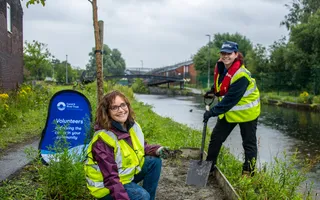After a career as a marine mechanical engineer, Bill Darch could have easily hung up his spanners to enter a well-earned retirement. But, fortunately for the National Waterways Museum, Ellesmere Port, he didn't.
He's been applying his life-time's experience to solve the engineering challenges posed by the museum's historic machinery and vessels.
Bill joined the museum in 1982, while he was still working, and his enthusiasm for his subject has not dimmed. He spends at least three days a week at the museum, working with the team and tending to his charges in the Power Hall and Pump House, or working in the machine shop on new displays. And, after a hard day at the museum, he sometimes retires to his second favourite haunt – the Horse and Jockey.
When Bill turned 80, he was honoured with the Marsh Trust Volunteer Specialist Award. Speaking of Bill, Canal & River Trust's head of the museum Graham Boxer said:
"Bill's unique background and skills are invaluable to our museum. He is utterly reliable and patient. For some years we'd been struggling to fix technical issues with steam boilers and been unable to run engines. Bill has stuck with them throughout and is still committed."
In addition to the award, Bill has been recognised with a Queen's Award for Voluntary Service as part of the Steam Tug Kerne Preservation Society.
What prompted you to become a volunteer?
I knew Jim McKeown (who's been with the museum since 1972) and he told me about an issue the museum was having with the old Weaver Packet Cuddington, I identified the problem, frost damage, and I'm proud to say my repair is still good today. I then got the engine running on the Clyde Puffer Basuto – another historic vessel. After that, I was hooked.
What do you do as a volunteer?
When I started, I focussed on the maintenance of Cuddington and Basuto. These are two fascinating ships. Basuto is the only one of her type left, built in 1903 she was still in use in the late 1980s.
I now look after the mighty engines in the Pump House and in the Power Hall. We get the ones in the Pump House ‘in steam' on the first Sunday of each month and on Bank Holidays. The reaction from visitors is always great, and many people return just to see the engines in action.
I've also been working on a new project – a carriage on our historic slipway. That's keeping me busy in the machine shop. When I'm not doing this, I'm helping to train the next generation of volunteer engineers. We welcome new people into the team, and I'm always on the lookout for potential candidates. I've even enlisted two of my young dart playing friends to get involved. We need to make sure we've got volunteers to keep us going into the future.
What did you do before you retired?
I was an Engine Room Artificer in the Royal Navy followed by a spell in the Merchant Navy as an Engineer and I then worked in industry. I travelled all over the UK and to North Africa and the Middle East before retiring at 60.
What keeps you coming back?
I love the steam pump engines and when they are in steam it's just wonderful. I'd love to see the Pump House given a higher profile. Without the Pump House Ellesmere Port would not have functioned. They drove the cranes, the winches, the capstans, everything. These mighty engines truly are the beating heart of the site.
I enjoy helping to keep these in working order - using my knowledge to keep an important bit of industrial heritage alive and functioning.
Why should people join you as a volunteer?
Without volunteers, these wonderful pieces of equipment will disappear. It's as simple as that. We need people. You don't have an engineering background. We will train you and find out what works for you. In return for your time you'll learn new skills, meet people and get the satisfaction of knowing you're helping keep something rare and precious alive for future generations to enjoy.
Finally – what is your favourite bit of the museum?
It's the seating area overlooking the top and lower basins. From here you can see the whole site, and I like to sit there and reflect on what it may have looked like in its heyday. With the massive ships unloading their cargoes, the vessels on the slipway and the machinery in full swing. What a place it must have been.
I recall seeing it in the 1960s, silted up canals and derelict buildings. I'm just pleased that fellow volunteers were here in the 1970s to bring the site back to life.





